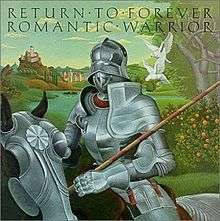Romantic Warrior
| Romantic Warrior | ||||
|---|---|---|---|---|
 | ||||
| Studio album by Return to Forever | ||||
| Released | 1976 | |||
| Recorded | February 1976 at Caribou Ranch, Colorado | |||
| Genre | Jazz fusion, progressive rock | |||
| Length | 45:28 | |||
| Label | Columbia | |||
| Producer | Chick Corea | |||
| Return to Forever chronology | ||||
| ||||
Romantic Warrior (1976) is the sixth studio album of fusion band Return to Forever.
Romantic Warrior is the band's bestselling, record reaching eventual sales of 500,000 copies. It was the group's first album made for Columbia Records, which may have had a positive effect on sales. This is also the first jazz-rock album by Return to Forever that was not recorded at New York City's Record Plant Studios; instead, it was recorded entirely at Caribou Ranch. It was also the first to be credited solely to Return to Forever, removing the "featuring Chick Corea" moniker. The album is more avant-garde and less funky than the band's previous album, No Mystery (1975).
Composition
Chick Corea contributed the longest compositions and the other members each composed one piece. The first track, Corea's "Medieval Overture", with its distinctive melodic motifs, sets the mood for the rest of the album. Lenny White's "Sorceress" starts with a funky riff and is distinguished by Corea's synthesizers. The title track is fully acoustic. It has a long intro, which is followed by a short theme consisting of one riff. Each group member (excluding White) plays a long solo. In the end, an extended outro follows, during which fast unison patterns are heard. Al Di Meola's and Stanley Clarke's songs on side two are notable for their humorous qualities. Al Di Meola's song, "Majestic Dance", relies on rock riffs and distorted lead guitar sound, but features also fast harpsichord-like synth figures. Clarke's "The Magician" is a very complex composition, featuring playful melodies, and again, rapid unison lines. The last track of the album is Corea's "Duel of the Jester and the Tyrant", which is the longest song of the album. It has a more conventional melody as a main theme, but otherwise it follows the style of previous tracks. Notable is the intense keyboard solo showcasing Corea.
After this album Corea decided that the group's time had come to an end and he continued with another wholly new Return to Forever line-up with Clarke. Corea dedicated the album to the founder of the Church of Scientology, L. Ron Hubbard.
Critical reception
| Professional ratings | |
|---|---|
| Retrospective reviews | |
| Review scores | |
| Source | Rating |
| AllMusic | |
| Christgau's Record Guide | D+[2] |
| The Rolling Stone Jazz Record Guide | |
In a retrospective review for AllMusic, William Ruhlmann praised Romantic Warrior as "the sound of a mature band at the top of its game, which may help explain why it was Return to Forever's most popular album, eventually certified as a gold record, and the last by this assemblage."[1] Robert Christgau was less enthusiastic about the record, deeming it "jazz-rock's answer to Emerson, Lake & Palmer--the worst of both worlds". He called Corea's compositions faux classical and "pompous", while deriding his group's playing as "dazzlingly vacuous".[2]
Track listing
- "Medieval Overture" (Corea) – 5:14
- "Sorceress" (White) – 7:34
- "The Romantic Warrior" (Corea) – 10:52
- "Majestic Dance" (Di Meola) – 5:01
- "The Magician" (Clarke) – 5:29
- "Duel of the Jester and the Tyrant" (Part I & Part II) (Corea) – 11:26
Personnel
- Al Di Meola – electric guitars, acoustic guitar, soprano guitar, handbells, slide whistle
- Chick Corea – acoustic piano, Fender Rhodes, Hohner Clavinet, Mini Moog, Moog 15, Micromoog, ARP Odyssey, Yamaha organ, Polymoog, marimba, percussion
- Stanley Clarke – Alembic bass with Instant Flanger, piccolo bass, acoustic bass, bell tree, handbells.
- Lenny White – drums, timpani, congas, timbales, handbells, snare drum, suspended cymbals, alarm clock.
with
- Dennis MacKay – Engineer & Remixing
- Wilson McLean – Cover art
Chart performance
| Year | Chart | Position |
|---|---|---|
| 1976 | Billboard 200 | 35[4] |
| 1976 | Billboard Jazz Albums | 3[4] |
| 1976 | Billboard R&B Albums | 23[4] |
References
- 1 2 Ruhlmann, W. (2011). "Romantic Warrior - Return to Forever | AllMusic". allmusic.com. Retrieved 20 July 2011.
- 1 2 Christgau, Robert (1981). Christgau's Record Guide: Rock Albums of the Seventies. New Haven: Ticknor & Fields. p. 322. ISBN 0-89919-025-1.
- ↑ Swenson, J. (Editor) (1985). The Rolling Stone Jazz Record Guide. USA: Random House/Rolling Stone. p. 50. ISBN 0-394-72643-X.
- 1 2 3 "Romantic Warrior - Return to Forever | Awards | AllMusic". allmusic.com. Retrieved 27 October 2013.